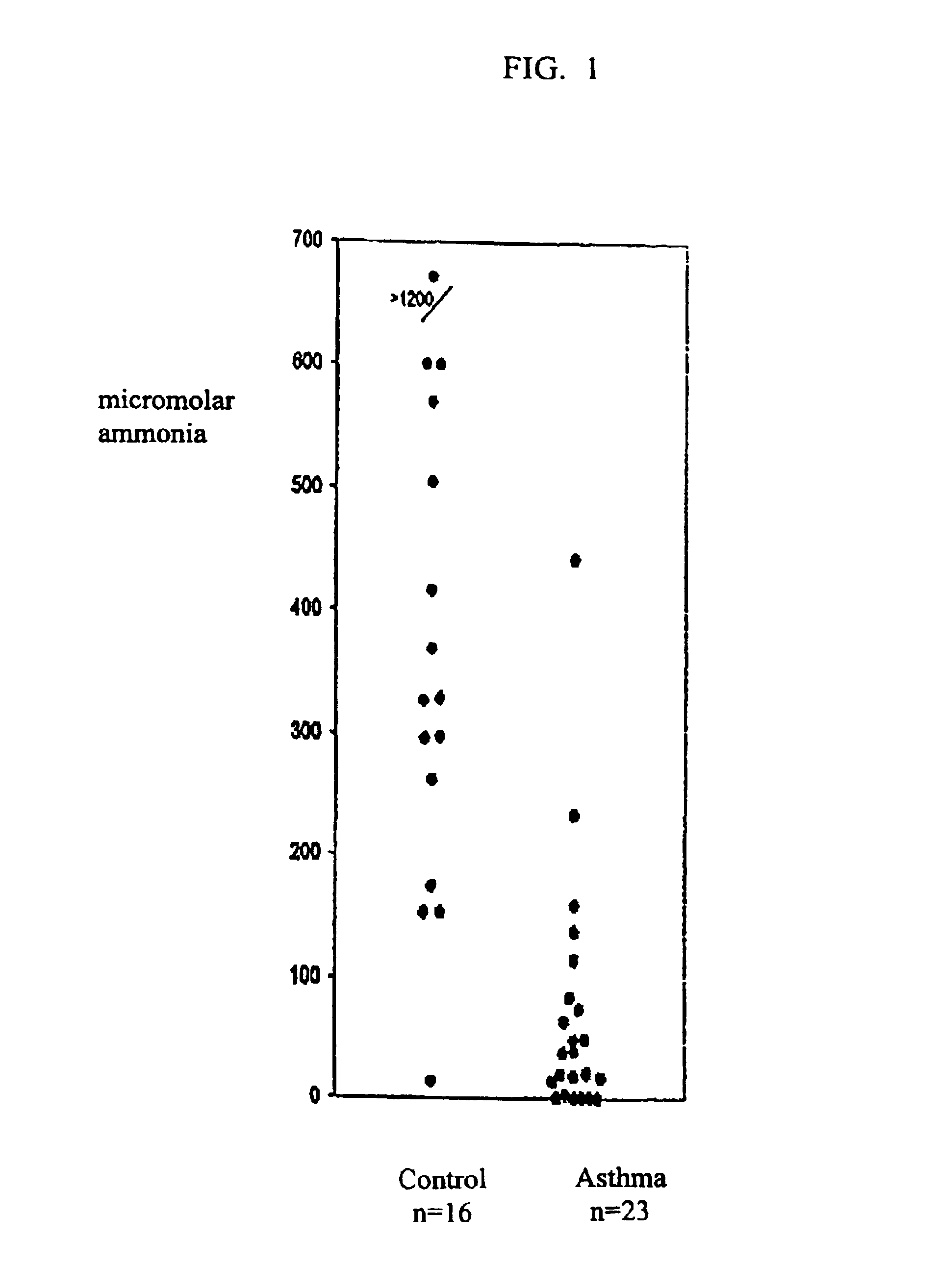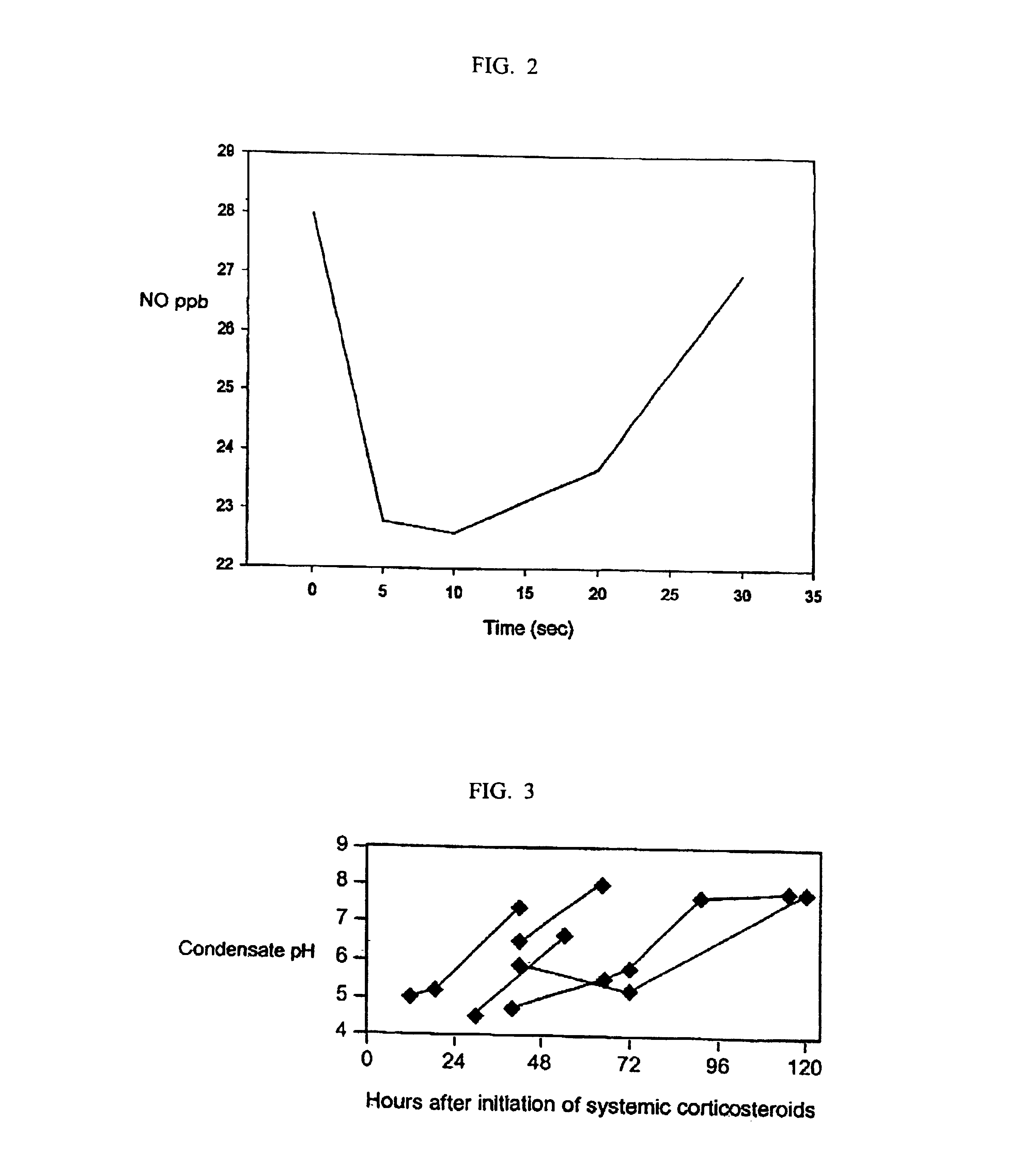Airway alkalinization as a therapy for airway diseases
a technology of airway alkalinization and asthma, which is applied in the direction of ammonia active ingredients, dispersed delivery, peptide/protein ingredients, etc., can solve the problems of acidification selectively injuring asthmatic airways, nitric oxide levels, and substantial injury to the airway epithelium
- Summary
- Abstract
- Description
- Claims
- Application Information
AI Technical Summary
Problems solved by technology
Method used
Image
Examples
example 1
Data Supporting the Hypothesis That Airway Acidification Contributes to the Pathophysiology of Acute Asthma.
[0041]Eosinophil Necrosis and Release of Cytotoxic Mediators is Enhanced in Allergic Asthmatic Subjects by Endogenous Airway Acidification During Viral Respiratory Infections.
[0042]Consistent with the established cellular toxicity of low pH-mediated protonation of NOx, applicants have recently described that human eosinophil necrosis (and overall cell death) are dramatically accelerated in the upper end of the pH range observed during acute asthma exacerbations compared to that observed in asymptomatic controls (Am J Respir Crit Care Med 161:694-699;2000). Further breath condensate pH falls during HRV 16 infection. This drop in pH affects both the upper and lower airways. Direct measurement of nasal lavage pH (though diluted by saline) in high IgE asthmatic and control subjects infected with HRV16 (n=3 each) revealed that the asthmatic subjects had high ECP levels (258-668 ng / ...
example 2
Data Supporting the Hypothesis That Airway Acid is Buffered by Ammonia, a Product of Epithelial Glutaminase.
[0046]Ammonium Concentrations are Low in Breath Condensate Specimens From Patients with Acute Asthma.
[0047]Specimens were collected from patients admitted to the hospital or seen in the emergency department with acute exacerbations of asthma (low pH) or from healthy volunteers (no history of asthma or any other obstructive lung disease and no chronic or acute illness). All patients with asthma had acute expiratory flow limitation, with auscultatory wheezing, an inspiratory to expiratory time ratio of 1) values 4+ concentration in asthmatic subjects (37; range, 0-442) was lower than in controls (314; range, 14-220) by Mann-Whitney rank-sum testing (p4+ concentrations were correlated with logarithmically-transformed H+ concentrations (pH) (r=0.59; p4+ levels (see FIG. 1).
[0048]Glutaminase Protein is Expressed in Human Airway Epithelial Cells.
[0049]Human kidney (KGA) and C-type (...
example 3
Determining Airway Acidification Contributes to the Pathophysiology of Acute Asthma
Methods
[0059]Ammonium Measurement
[0060]Concentrations will be determined by the Sigma Diagnostics method. Briefly, condensed exhaled airway fluid vapor and supernatant from native tracheobronchial secretions will be reacted with NADPH in the presence of L-glutamate dehydrogenase which reductively aminates added 2-oxoglutarate. The decrease in absorbance at 340 nm reflects NADPH oxidation and is proportional to NH3 concentration.
[0061]Breath Condensate 3NT Measurements.
[0062]These will be performed as reported by Hanazawa and coworkers (Am J Respir Crit Care Med 162:1273-1276, 2000). Subjects will breathe through a mouthpiece and a two-way nonrebreathing valve which also serves as a saliva trap. Nitrotyrosine will be measured with a specific enzyme immunoassay according to the manufacturer's indtructions (Cayman Chemical, Ann Arbor, Mich.).
[0063]Bronchial Epithelial Biopsy.
[0064]Following administratio...
PUM
| Property | Measurement | Unit |
|---|---|---|
| concentrations | aaaaa | aaaaa |
| expiratory time ratio | aaaaa | aaaaa |
| width | aaaaa | aaaaa |
Abstract
Description
Claims
Application Information
 Login to View More
Login to View More - R&D
- Intellectual Property
- Life Sciences
- Materials
- Tech Scout
- Unparalleled Data Quality
- Higher Quality Content
- 60% Fewer Hallucinations
Browse by: Latest US Patents, China's latest patents, Technical Efficacy Thesaurus, Application Domain, Technology Topic, Popular Technical Reports.
© 2025 PatSnap. All rights reserved.Legal|Privacy policy|Modern Slavery Act Transparency Statement|Sitemap|About US| Contact US: help@patsnap.com



